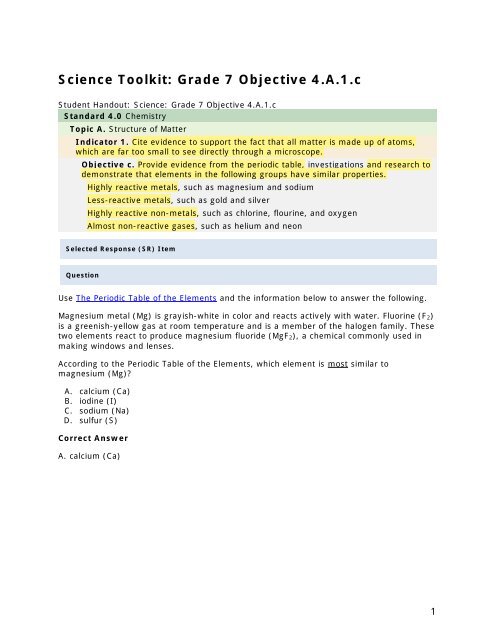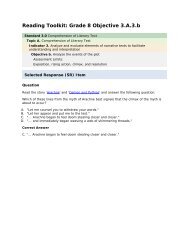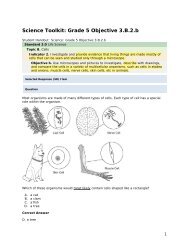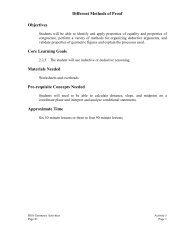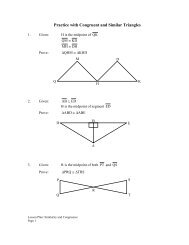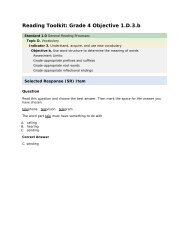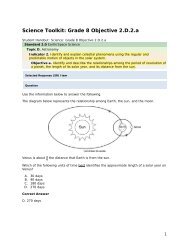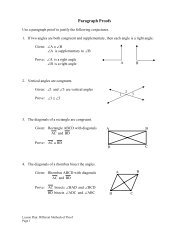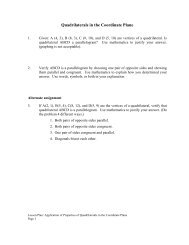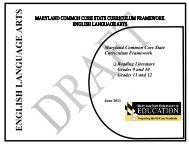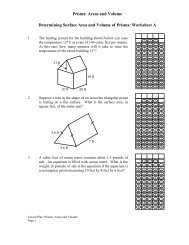You also want an ePaper? Increase the reach of your titles
YUMPU automatically turns print PDFs into web optimized ePapers that Google loves.
<strong>Science</strong> Toolkit: Grade 7 Objective <strong>4.A.1.c</strong><br />
Student Handout: <strong>Science</strong>: Grade 7 Objective <strong>4.A.1.c</strong><br />
Standard 4.0 Chemistry<br />
Topic A. Structure of Matter<br />
Indicator 1. Cite evidence to support the fact that all matter is made up of atoms,<br />
which are far too small to see directly through a microscope.<br />
Objective c. Provide evidence from the periodic table, investigations and research to<br />
demonstrate that elements in the following groups have similar properties.<br />
Highly reactive metals, such as magnesium and sodium<br />
Less-reactive metals, such as gold and silver<br />
Highly reactive non-metals, such as chlorine, flourine, and oxygen<br />
Almost non-reactive gases, such as helium and neon<br />
Selected Response (SR) Item<br />
Question<br />
Use The Periodic Table of the Elements and the information below to answer the following.<br />
Magnesium metal (Mg) is grayish-white in color and reacts actively with water. Fluorine (F 2 )<br />
is a greenish-yellow gas at room temperature and is a member of the halogen family. These<br />
two elements react to produce magnesium fluoride (MgF 2 ), a chemical commonly used in<br />
making windows and lenses.<br />
According to the Periodic Table of the Elements, which element is most similar to<br />
magnesium (Mg)?<br />
A. calcium (Ca)<br />
B. iodine (I)<br />
C. sodium (Na)<br />
D. sulfur (S)<br />
Correct Answer<br />
A. calcium (Ca)<br />
1
<strong>Science</strong> Toolkit: Grade 7 Objective <strong>4.A.1.c</strong><br />
Question<br />
Use The Periodic Table of the Elements and the information below to answer the following.<br />
Magnesium metal (Mg) is grayish-white in color and reacts actively with water. Fluorine (F 2 )<br />
is a greenish-yellow gas at room temperature and is a member of the halogen family. These<br />
two elements react to produce magnesium fluoride (MgF 2 ), a chemical commonly used in<br />
making windows and lenses.<br />
According to the Periodic Table of the Elements, which element is most similar to<br />
magnesium (Mg)?<br />
A. calcium (Ca)<br />
B. iodine (I)<br />
C. sodium (Na)<br />
D. sulfur (S)<br />
2
<strong>Science</strong> Toolkit: Grade 7 Objective <strong>4.A.1.c</strong><br />
Handouts<br />
The Periodic Table of the Elements<br />
3


